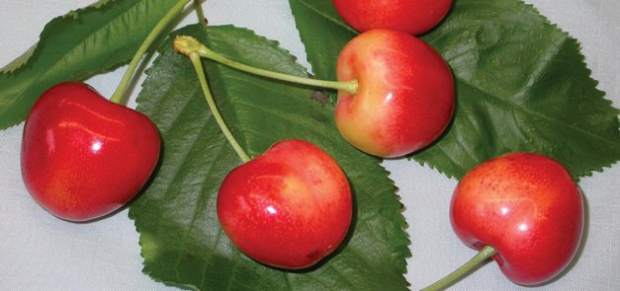
Starletta blush cherries were bred in Summerland, British Columbia.
Photo courtesy of PICO
But two new blushed cherry varieties developed in British Columbia are about to be released at the request of growers and nurseries in other parts of the world. The varieties were bred at Agriculture and Agri-Food Canada, at Summerland, and are being licensed by the Okanagan Plant Improvement Company (PICO), which handles the commercialization of Summerland apple and cherry varieties.
Starblush (13N-07-39 cultivar) is from a cross of 2N-63-20 (Bing x Salmo) and Stella made by former breeder Dr. David Lane in 1976. The fruit is very large (over 12 grams) and highly blushed, but the blush is darker than on most yellow cherries and can be slightly mottled. The cherry is very sweet with good flavor. It matures about three days after Lapins. This variety has been requested by a New Zealand nursery and a group of growers in Oregon.
Starletta (SPC 207 cultivar) is from a cross of Stella and 2S-84-10 also made by Lane in 1976. It has large fruit with good tolerance to cracking. The fruit is firm with a bright flush, and has good flavor with some acidity. It matures about ten days after Van. The variety is being released at the request of New Zealand nursery grower Andy McGrath and Jean-Pierre Darnaud with International Plant Selection in France, who have been testing it. Starletta will be available throughout Europe as an open release.
British Columbia has had a cherry breeding program at the Agriculture and Agri-Food Canada research station in Summerland since 1936, but developing blushed varieties was not a goal until recently. Apple and cherry breeder Dr. Cheryl Hampson said breeders used to walk straight by seedlings that turned out to be blushed.
Ken Haddrell, operations manager with PICO, said about 10 percent of the program’s cherry seedlings have turned out to be blushed, which is not what most Canadian growers want, unless they sell their fruit at the farm. However, PICO commercializes varieties around the world, including places where blushed cherries are in demand. And so, in recent years, breeders have begun to pay attention to blush selections.
Summerland’s first blush cherry, an early-maturing cherry called Sue, was named in 1954. More than a half century went by before the program released its second blush cherry, Stardust (13N-07-70 cultivar), in 2008.
Stardust came from the same cross of 2N-63-20 and Stella as Starblush. It is self-fertile and matures about five days after Rainier (around July 18 in Summerland). While exceptionally large and firm, it has been judged less sweet and flavorful than Rainier.
Although the B.C. breeding program has traditionally focused on developing large, late-season cherry varieties, Hampson said she’s been making crosses for early and midseason cultivars, too, because growers are wanting to bring in the harvest crew earlier and keep workers all season. She has some promising early-season selections, including a very large, early, blush cherry, that have the potential to extend the season on the front end for B.C. growers. The breeding program is also looking for varieties with better storability, so fruit can be shipped more successfully by sea, and improved mildew resistance.

Leave A Comment